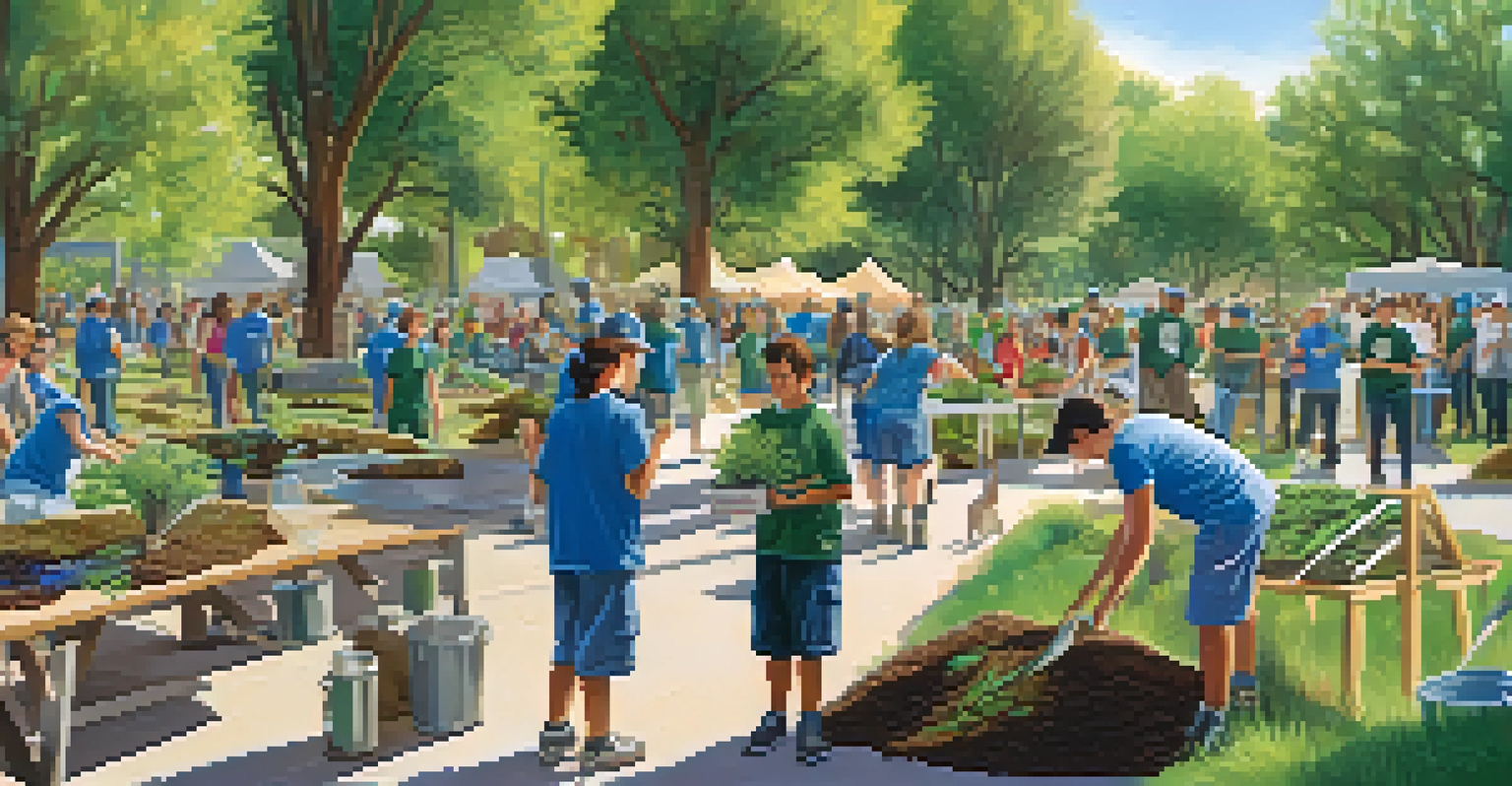Restoration Projects: Rehabilitating Nevada's Natural Areas

Understanding Restoration Projects in Nevada
Restoration projects in Nevada focus on rejuvenating the state’s diverse ecosystems, which have been impacted by various human activities. From urban development to mining, these projects aim to reverse damage and restore natural habitats. By prioritizing biodiversity, these initiatives work to ensure that native species have a safe environment to thrive.
The restoration of our ecosystems is essential for our own survival; it is a partnership of nature and humanity.
One of the key goals of these projects is to enhance ecological resilience, allowing ecosystems to better withstand climate change and other environmental stresses. For instance, replanting native vegetation can help stabilize soil and improve water quality, benefiting both wildlife and local communities. This holistic approach ensures that restoration efforts address multiple environmental concerns simultaneously.
As these projects unfold, they often involve collaborations among government agencies, non-profit organizations, and local communities. Such partnerships are crucial for securing funding, expertise, and volunteer support, fostering a sense of shared responsibility for Nevada’s natural heritage.
Highlighting Successful Restoration Projects
Several successful restoration projects in Nevada serve as inspiring examples of what can be achieved. One notable project is the restoration of the Lahontan cutthroat trout habitat in Lake Tahoe, which involved removing invasive species and reintroducing native fish. This effort not only revitalized the fish population but also improved the overall health of the aquatic ecosystem.

Another impressive initiative is the restoration of the Nevada wetlands, which aims to increase biodiversity and improve water quality. By creating new wetland areas and rehabilitating existing ones, these projects support various wildlife species, including migratory birds that rely on these habitats during their journeys. The transformation of these landscapes has brought both ecological and recreational benefits to the region.
Restoration Projects Enhance Ecosystems
Nevada's restoration projects aim to rejuvenate diverse ecosystems impacted by human activities, prioritizing biodiversity and ecological resilience.
These success stories highlight the potential of restoration projects to make a significant impact on Nevada’s natural areas. They showcase the power of community engagement and scientific research in driving positive environmental change, setting a precedent for future efforts.
The Role of Community in Restoration Efforts
Community involvement is crucial for the success of restoration projects across Nevada. Local residents bring invaluable knowledge about the land, its history, and the specific challenges it faces. By participating in restoration activities such as planting trees or removing invasive species, community members feel a deeper connection to their environment and take pride in its preservation.
We won't have a society if we destroy the environment.
Additionally, educational programs and volunteer opportunities empower individuals to become active stewards of their natural surroundings. Workshops and hands-on experiences can increase awareness of ecological issues and inspire residents to advocate for sustainable practices in their daily lives. This grassroots involvement creates a ripple effect, encouraging more people to support restoration initiatives.
Through collaborative efforts, communities can also help secure funding and resources for ongoing projects. By voicing their support to local governments and organizations, residents play a vital role in shaping the future of Nevada’s landscapes, ensuring that restoration efforts continue to thrive.
Challenges Faced in Restoration Projects
While restoration projects in Nevada have achieved significant milestones, they also face various challenges. One major hurdle is funding; many projects rely on grants and donations, which can be unpredictable. Securing consistent financial support is essential for maintaining momentum and ensuring the long-term success of these initiatives.
Another challenge involves the complexity of restoring ecosystems that have been altered for decades. Factors such as climate change, invasive species, and urban development can complicate restoration efforts, requiring adaptive management strategies. Addressing these challenges demands ongoing research, flexibility, and innovative solutions.
Community Involvement is Key
Active participation from local communities is crucial for the success of restoration efforts, fostering a deeper connection to the environment and ensuring ongoing support.
Lastly, engaging the public and raising awareness about the importance of restoration is crucial. Despite the benefits, some community members may not fully understand the need for these projects or how they can contribute. Effective communication and outreach efforts are vital for fostering community support and participation in restoration activities.
Innovative Techniques in Restoration
As restoration projects evolve, innovative techniques are being implemented to enhance their effectiveness. For instance, ecological engineering involves designing and constructing habitats that mimic natural ecosystems, which can accelerate recovery processes. This approach not only restores function but also fosters biodiversity, creating resilient environments.
Another promising technique involves the use of drones for monitoring and mapping restoration sites. Drones can efficiently gather aerial data, helping researchers assess the health of ecosystems and track changes over time. This technology allows for more precise management decisions and can improve overall project outcomes.
Additionally, the incorporation of traditional ecological knowledge from Indigenous communities enriches restoration practices. By blending modern science with centuries-old wisdom about land stewardship, projects can become more culturally relevant and successful. This collaboration fosters a holistic approach to restoration, ensuring that diverse perspectives are valued.
The Importance of Monitoring and Evaluation
Monitoring and evaluation are critical components of any restoration project, as they help assess progress and identify areas for improvement. By establishing clear metrics and benchmarks, project leaders can gauge the effectiveness of their efforts and make data-driven decisions. This ongoing evaluation ensures that projects remain adaptable and responsive to changing environmental conditions.
Regular monitoring also allows for the identification of potential issues before they escalate, such as the resurgence of invasive species or changes in species populations. By addressing these challenges early on, restoration teams can implement corrective actions and support the long-term success of their initiatives. This proactive approach is essential for maintaining the health of restored ecosystems.
Challenges and Innovations Ahead
While facing funding and ecological complexities, innovative techniques and technology continue to shape the future of restoration projects in Nevada.
Furthermore, sharing the results of monitoring efforts with the community fosters transparency and encourages continued support for restoration projects. When residents see the tangible benefits of their involvement and the positive impacts on their environment, they are more likely to engage in future initiatives. This cycle of monitoring, evaluation, and community engagement strengthens the foundation of successful restoration efforts.
Future Directions for Nevada's Restoration Projects
Looking ahead, the future of restoration projects in Nevada appears promising, with new opportunities on the horizon. Increased awareness of environmental issues, coupled with growing public support, suggests that more resources may become available for restoration efforts. As communities recognize the value of healthy ecosystems, they are likely to advocate more strongly for funding and policies that prioritize restoration.
Moreover, advancements in technology will continue to shape the landscape of restoration. Innovations in data collection, monitoring, and habitat design will enable more effective and efficient projects. As researchers and practitioners embrace these tools, they will be better equipped to tackle the complex challenges facing Nevada’s natural areas.

Lastly, fostering collaborations among diverse stakeholders will be essential for maximizing the impact of restoration projects. By uniting government agencies, non-profits, businesses, and local communities, Nevada can create a robust network of support for restoration initiatives. This collaborative spirit will ensure that restoration efforts not only continue but thrive, benefiting both the environment and future generations.